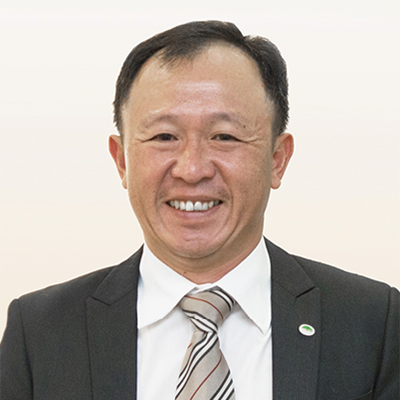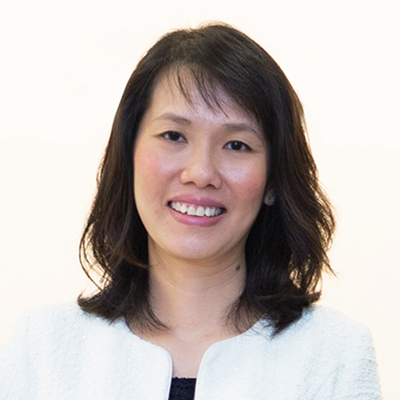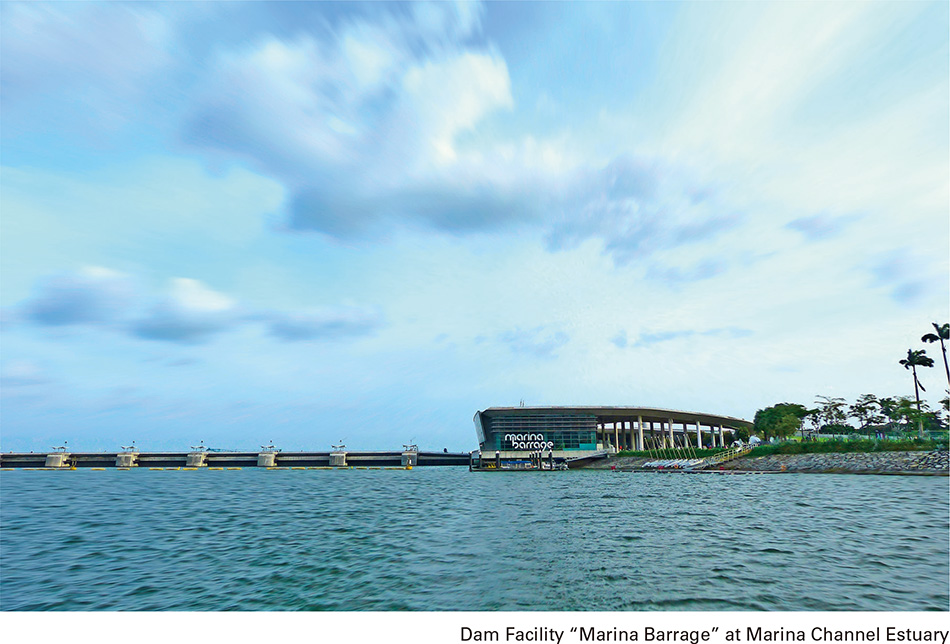GLOBAL INNOVATION REPORT
As a country lacking natural water bodies, Singapore has to be creative in managing its water using reclaiming or desalination. This article traces the development of the water story in Singapore and how Hitachi Aqua-Tech Eng. has grown alongside this development. It also aims to forecast the role it can play in the future development of water in the region.



As a country that lacks natural water bodies, Singapore has to be creative in its water management. Today, Singapore has built a sustainable supply from four sources: water from local catchments, imported water, high-grade reclaimed water (known as NEWater), and desalinated water. In 2010, Singapore’s dam project, Marina Barrage, won the Asia Pacific Regional Project Innovation Awards in the Design by International Water Association. In 2014, NEWater won the “Water for Life” United Nations Water Best Practices Award. In 2019, its Tuas Desalination Plant was named the Desalination Plant of the Year at the Global Water Awards at the Water Summit in London, UK. Singapore has become a recognized leader for its resourcefulness in water management.
Hitachi Aqua-Tech Engineering Pte. Ltd. (HAQT), located in Singapore, provides water solutions to government bodies and businesses in Southeast Asia. Its growth has largely mirrored this water development story and as the water demand around the region grows, HAQT expects to ride this wave of development.
This article traces the development of the water story in Singapore and how HAQT has grown alongside this development. It also aims to forecast the role that HAQT can play in the future development of water in the region.
Singapore has built a diversified and sustainable water supply known as the Four National Taps. Currently, the water from these sources are as follows: rainwater collection, recycled water (40%), and desalination (25%). The long-term plan is to become entirely self-sufficient in water. PUB aims to have desalination and NEWater capacities meet up to 85 % of Singapore’s water needs by 2060. In integrating the water system and maximizing the efficiency of each of the four national taps, Singapore has overcome its lack of natural water resources. This progress is certainly a far cry from the prognosis given in 2015 by the Washington-based Water Resource Institute, which listed Singapore as one of the most water-stressed countries in the world(3).
Aqua-Tech Engineering & Supplies Pte. Ltd., the predecessor of HAQT, which provides water solutions to Southeast Asia, was a small enterprise that opened in 1977. It lacked financing, technologies, talent, and a brand name. With these challenges, the company looked beyond Singapore and managed to obtain sole distributorship for Culligan (USA & Italy) products for the Singapore market.
Using an established brand name like Culligan helped the company grow by promoting small industrial water treatment systems such as filtration systems, softeners, deionizers, and reverse osmosis systems. However, one key challenge was keeping its costs competitive because of the long shipping period and high cost of bringing skilled personnel from USA and Italy to commission and troubleshoot the imported systems. After a few years, the company started to build its own capabilities by hiring highly skilled engineers, and to manufacture and assemble its own water treatment systems.
As Singapore industry growth was doing well, it has attracted many international water treatment companies competing with the company. Being a small company, it was at a disadvantage with customers who prefer a more established company to undertake their projects.
While the prospects were still promising, the need to venture overseas into new markets was important for the survival of the company. By chance in the 1980s, Aqua-Tech was invited to design and supply a seawater reverse osmosis (SWRO) plant for the Republic of Maldives. Realizing that Maldives was still a blue ocean with no “real” competitors, Aqua-Tech started to invest largely into SWRO systems and shifted its focus to this niche market. It also diversified into supplying conventional sewage treatment plants to treat sewage water. This proved crucial for the company’s success in the Maldives. At its peak, the company had about an 80% market share in the Maldives (see Figure 1).
Year 2009 was a watershed year for the company as it was acquired by Hitachi, Ltd. and became Hitachi Aqua-Tech Engineering Pte. Ltd. (HAQT). From a local small and medium-sized enterprise to a multinational corporation, the challenges facing Hitachi Aqua-Tech Engineering included language, working culture differences, and working procedures. However, both companies shared similar values such as being customer-centered, placing a strong emphasis on product quality and reliability, and having a “never shirk responsibility” attitude. Its manpower has grown from 25 employees to 170 employees. Sales revenue has grown seven-fold (since the 1970s) while remaining profitable in all of the past 10 years since joining the Hitachi Group. Office and factory space has increased from its original approximately 1200 m2 to its current approximately 3,000 m2 (see Figure 2).
HAQT has diversified its sewage treatment businesses by leveraging Hitachi’s membrane bio-reactor (MBR) technology. Hitachi’s MBR system uses an advanced treatment technology that produces high-quality reuse water at a competitive cost and has a smaller footprint compared to conventional sewage treatment systems. It is an ideal solution for customers with limited space available for waste water treatment systems.
In 2012, HAQT made a strategic business decision to move into the highly priced but technologically demanding oil and gas floating, production, storage, and offloading (FPSO) market for which only a few companies in the world are accredited.
Then, in 2016, HAQT merged with a leading Singapore swimming pool and water features construction specialist, Aqua Works & Engineering Pte. Ltd. It aims to provide a one-stop solution for its customers. This merger has created a synergy in HAQT’s business, adding new products and service lines and geographically expanded Aqua Works’ business. In 2019, HAQT successfully completed the installation work for the world’s tallest indoor waterfall feature in Singapore’s new iconic building, Jewel, located in Singapore Changi airport (see Figure 3).
Figure 3 | Artificial Waterfall in Commercial Facility “Jewel” adjacent to Singapore Changi Airport
To stay ahead of the competition, HAQT has upgraded its in-house enterprise resources planning (ERP) system to improve the efficiency and enhance productivity. The company is also working on creating a predictive maintenance software, an online monitoring platform to monitor water plants in real time as well as to provide customers information on inventory levels at HAQT.
Talent retention has always been a huge challenge in the Asia employment market including Singapore. The Y and Z generations, young people born after the 1980s, are constantly looking for employment opportunities to enhance their working experiences after a few years working in the same company.
To overcome this challenge, HAQT has adopted a few strategies such as providing a conducive working environment by implementing a flexible workplace, flexible working times, and establishing a recreational club. This has allowed employees to handle their work and personal needs with a balanced approach. The managers also conducted department meetings over breakfasts or lunches with their teams instead of in the office.
Aligning employees’ remuneration to market standards, constant employee engagements, empowerment to encourage decision-making and identifying the next generation of potential leaders are all crucial strategies in talent retention.
Water is fundamental to all life. According to an Asia Development Bank report, the world population could reach 10 billion by 2050 and global demand for water is expected to increase by 55%. By 2050, more than 60% of the Asia and Pacific region’s population will be living in cities. And, out of the world’s 22 megacities, 13 are in Asia, and by 2025, the number is expected to grow to 20 megacities. However, about 1.7 billion people lack simple sanitation and close to 80% of wastewater is being discharged into rivers, lakes, and sea with little or no treatment at all. For example, in Indonesia, only 14% of wastewater is treated, while in the Philippines, only 10% is treated, followed by only 9% in India, and 4% in Vietnam. As these values indicate, the current wastewater treatment rate is extremely low(5).
In 2015, the United Nations announced 17 Sustainable Development Goals (SDGs) to be achieved by 2030, with goals to end poverty, challenging inequality and injustice, and handling climate change.
In 2017, the Hitachi Executive Sustainability Committee considered all of the 17 SDGs and committed to pursuing five of these goals through its business strategy directly while pursuing the other six goals via its corporate commitment to society and across all businesses within Hitachi.
Over the years, Hitachi has invested many resources into research and development and developed some patented water treatment technologies that can be useful especially in developing ASEAN countries, such as the Philippines, Thailand, Vietnam, and Indonesia etc.(6) (see Table 1).
Amidst the economy expansion, industrialization, and urbanization are usually the key economic drivers. While developing countries enjoy the fruits of economic successes, there are trade-offs such as increased clean potable water demand, water and air pollution, excessive extraction of ground water, demand for clean industrial water, unregulated discharge of industrial and domestic waste water.
The following are some of the unique technologies and experiences that Hitachi has developed that it can share with the outside world:
Hitachi is a highly diversified company with over 900 companies and more than 300,000 employees globally. With the enormous potential in developing countries and the right strategies, it is still very possible to find blue oceans. Starting from developing small to medium scale projects with local businesses to get to know the native business culture and establishing the Hitachi brand name locally can lead to a more sustainable business in overseas markets.
HAQT aims to tap Hitachi’s technological prowess to create innovative solutions for customers. The company will continue striving to deliver commercially competitive solutions that drive profitability in order to create more sustainable growth for customers and society.